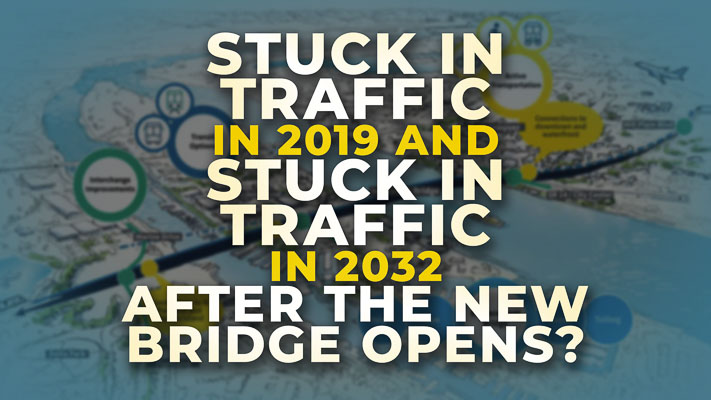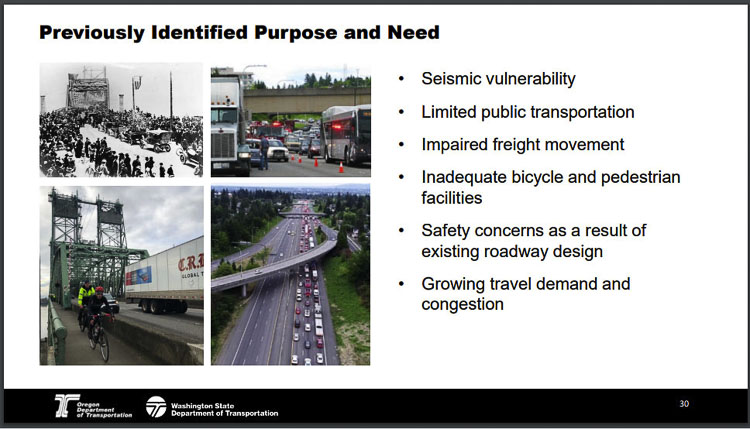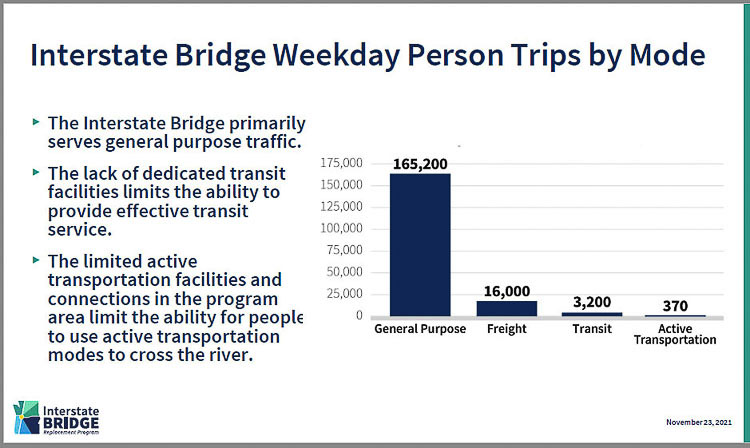
Portland officials push to reduce vehicle miles traveled while the people want improved travel times
Last Thursday was a busy day for the Interstate Bridge Replacement Program (IBR). The Community Advisory Group (CAG) met and grappled with the reality of the Purpose and Need Statement hamstringing options for a replacement bridge.
Program Administrator Greg Johnson missed the meeting because he was participating in the Metro Board meeting in Portland, where they were wrestling with demands by environmentalists and the “No More Freeways” groups who hoped to stop Metro from approving $36 million in Oregon funding to keep the IBR program moving forward. These groups lamented that the IBR failed to reduce vehicle miles traveled (VMT) and would allegedly be increasing greenhouse gasses from cars and trucks.
In November, the IBR team shared information on average weekday Interstate Bridge trips from 2019. General purpose trips are over 10 times greater than freight trips, 50 times greater than transit trips, and over 445 times greater than active transportation trips. Yet, all are given equal standing in the IBR’s Purpose and Need statement.
CAG member Sam Kim lamented the lack of information regarding why an immersed tube tunnel (ITT) wasn’t being considered. He was apparently responding to the communications from Bob Ortblad, who has provided a great deal of information about the benefits of a tunnel. Four options were removed from consideration last September.
Tom Gentry highlighted the failure of any of the proposed solutions to actually improve travel times, which is overwhelmingly what people want. Community surveys indicate 70 percent of people want to reduce traffic congestion and improve travel time.
Community Advisory Group member Tom Gentry asks IBR’s Ray Maybe how the project will meet the citizens’ desire for improved travel and transit times. All the information so far indicates that with three through lanes, there will be no improvement. Maybe responds with references to other modes of transportation, including transit. Video courtesy IBR CAG meeting.
“The number one criteria after seismic, has been the transit time,” Gentry said. “Yet the four solutions that you proposed; when the bistate (committee) and the executive group have asked for how much time (will be saved); every time the answer has been – we don’t know. It might be one minute, we don’t know.”
IBR’s Ray Maybe responded to Kim, “in the previous efforts, CRC tunnel options were studied, and screened out because they didn’t meet the Purpose and Need.” He indicated the required depth to meet the needs for the shipping channel of the Columbia River would make the grade unacceptable. It would require them to bypass SR-14 and Hayden Island, according to Maybe.
Did Maybe inadvertently admit that the project must include light rail?
ITT construction requires an “open pit” that would later be covered up, according to Maybe. “So you can imagine what that looks like, across the river and on the banks of Oregon and Washington as you do an open pit for something that’s as wide as you would need to handle the traffic, the light rail, and the pedestrians and bicyclists that would be venturing into a tunnel like that.”
CAG member Tom Hickey asked for clarification. “When we talk about something not meeting the Purpose and Need, can we get more subtle about what that means? Not meeting the purpose and need it’s not like a light switch. It’s a matter of degree.”
How many CAG members and how many citizens understood a year ago? When they pushed for or against certain elements, did they truly understand the wording in the Purpose and Need (the problem statement) would eliminate certain legitimate options by the way it was worded and the elements it contained?
Maybe’s response was that congestion can be solved in different ways. “Providing options, either through high capacity transit, or active transportation for those who want to, can or need to walk, bike or roll.” He said they would be improving connections, the on off ramps, and for safer and more efficient access on and off the highway.
“But I think we’re really looking at focusing on reliable travel times,” Maybe said. Community surveys indicated people want to save time, not have a reliably slower travel time.
Gentry pushed back, saying he’s studied the information and understands Maybe’s response. With the project’s geographic limitations and their choice to limit the bridge to three through lanes, “you’re not going to be able to increase transit input, you’re not going to improve the transit time unless you move it elsewhere,” he said. “We have limited our ability to respond to the public. That is still my major concern.”
Hickey sought more details to see how close or how far something “misses the target.”

Maybe responded that the Purpose and Need is the “problem statement” that defines what the project must fix. Regarding possible solutions, “every one of those, if they don’t make one, then they’re screened out,” he said.
CAG co-chair Lynn Valenter said this level of discussion at the meeting was good. “I think the points that are being made here are worthwhile for us to spend time on. We hadn’t anticipated in this meeting that we would spend time exploring all of these different kinds of components that I think are really important.” She asked that the IBR team prioritize them for the next CAG meeting.
$36 million approved by Metro
Across the river, the Metro Board met to consider approving $36 million in Oregon funds to allow the IBR to continue its planning and efforts to create a replacement bridge. The IBR team has requested an additional $71 million in funding from the two states. All but two citizen’s comments objected to the expenditure of the funds, according to one news report.
The Metro Council voted 5-1 in favor of funding the project, with Councilor Mary Nolan being the sole objector. Bike Portland reported:
“There was a lot of tension around this vote because it’s a rare opportunity for Metro – one of eight official federal partners on the IBR project — to assert some influence over a freeway expansion project. Given the well-documented failure of the Columbia River Crossing project in 2013 (which this IBR project is based on) and heightened debate and urgency around the negative impacts of driving and freeways, Metro councilors were in the unenviable position of simultaneously staring down the freeway industrial complex and a burgeoning climate justice movement.”
There was a great deal of discussion including amendments to the Metro position on the bridge and concerns about “climate,” reducing vehicle miles traveled, improving transit ridership, strong support for congestion pricing, and other ways to get people out of their cars. They are grappling with similar pressure regarding the ODOT Rose Quarter project.
Three groups penned a letter after the meeting. They were: No More Freeways, 1000 Friends of Oregon and The Street Trust. “We hope open communication and precise analysis of the options on the table will help ODOT and the IBR leadership right-size this project and create high quality multimodal transportation and positive community impacts.”
Administrator Johnson led off the discussion by telling council members they don’t have as much power to “right-size” the bridge as they might have thought. He told the council members the only tool the IBR team will use to determine the size of the bridge will be regional traffic modeling.
Councilor Shirley Craddick wasn’t pleased to hear that. “Your data says we have a lot of cars and need a bigger bridge,” she said. “But we can no longer accommodate that and have a healthy world, or maybe even a world at all … We’re basically saying we can’t tolerate a bridge that is 10 or 12 lanes wide.”
Yet Johnson’s team will offer a final solution for a bridge design by the end of June. It will include only three through lanes and a form of high capacity transit, all before they report traffic modeling data later in the fall of 2022.

Johnson spoke strongly about the IBR project’s intentions to take climate change and other concerns seriously. But in the end, he said, “We must look at the data,” when it comes to determining the freeway design.
He also responded to Metro’s concerns by saying they aren’t the only voice at the table. “I need everyone [on Metro Council] to understand that this is a bi-state program with eight partners that have individual needs … We’re trying to thread the needle to address all of those concerns,” he said.
Being data driven
Not mentioned was the “old” data from the failed Columbia River Crossing (CRC). Transportation architect Kevin Peterson has repeatedly referenced data predicting 184,000 daily vehicle movements on I-5 by 2030, two years before the replacement bridge is projected to open. That translates to 5.6 lanes needed in each direction. By 2058 there were 288,000 daily vehicle movements requiring 8.3 lanes in each direction.
That is the “old” data that Craddick doesn’t want discussed. Updated numbers are potentially higher. The pandemic has caused fewer people to trust using mass transit. Both TriMet and C-TRAN have announced cuts in service for 2022. TriMet predicts it will take six years for their ridership to return to pre pandemic levels.
Metro did make three additions to the Values, Outcomes, and Actions (VOA) document, in an effort to placate those in opposition to the project. They included commitments to lower vehicle miles traveled (VMT), conduct an “investment-grade” financial analysis to determine how wide the freeway needs to be, and to include a comprehensive health impact assessment for communities along the five-mile project corridor between Portland and Vancouver.
Metro President Lynn Peterson said, “The intent of this is to make sure that we’re right-sizing the bridge.” Last May she praised Johnson’s commitment to being data driven at a meeting of the IBR’s Executive Steering Group. Yet her definition of “right-size” is a maximum of three lanes.
CAG member Tom Hickey seeks more information about alternatives and the requirements of the Purpose and Need statement. Several options have been excluded and he wants to understand the details. Video courtesy IBR CAG meeting.
“The Portland region has a policy of only three through lanes in each direction,” Peterson said last March. She had previously served as secretary of transportation in Washington. “We are still working on the rest of our system to make sure that there are three lanes in each direction,” she said. “This portion already has three lanes in each direction.”
In November, the IBR team shared data regarding trips using the Interstate Bridge. There are 165,200 general purpose trips, 16,000 freight trips, 3,200 transit trips, and 370 “active transportation” trips on an average weekday. In July, C-TRAN announced a reduction in their cross-river “express” service to Portland.
Johnson promised his team will look at “opening day traffic in 2032” and seek to project what that traffic would look like under numerous scenarios and alternatives. He believes his team can deliver that information by April.
At a November meeting of the 16-member Bistate Bridge Committee of state legislators, Oregon’s Sen. Lee Beyer (Democrat, Springfield) offered a summation at the end of the meeting. He appreciated the transportation demand presentation, but it wasn’t clear to him that the IBR team and legislators were looking to the future.
“We’re building the bridge, or trying to build a bridge that will be a 100-year bridge,” he said. “As we’re looking at what the capacity or demand for that bridge is going to be into the future, I think we need to make sure that we’re looking ahead and say what is that going to be for another 10 or 20 years. It’s gonna be hard to go back and adjust that bridge once it’s built.”




